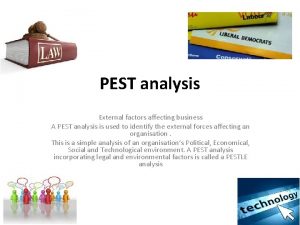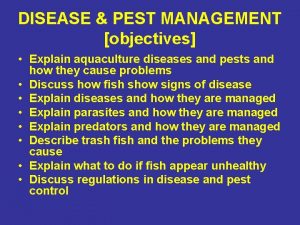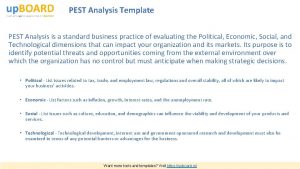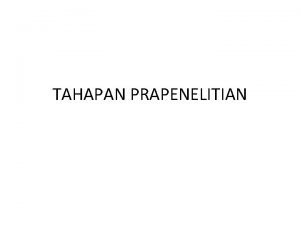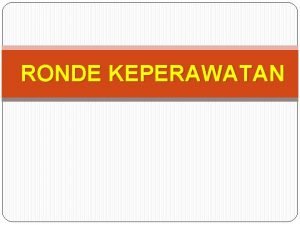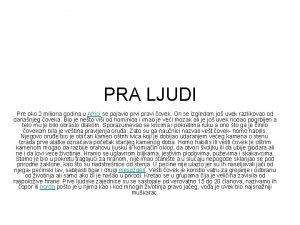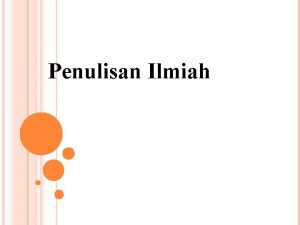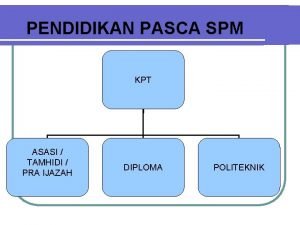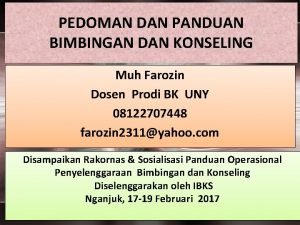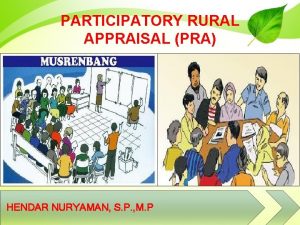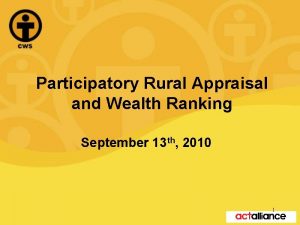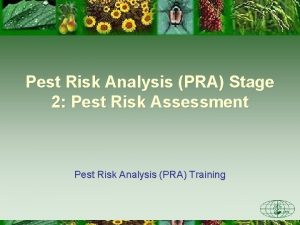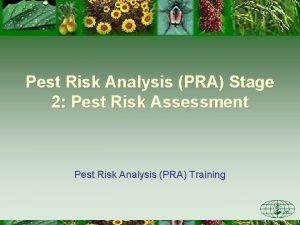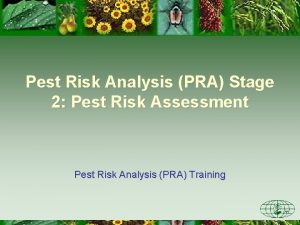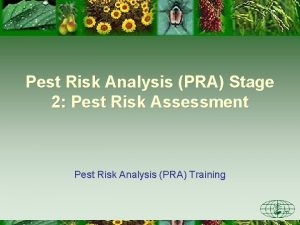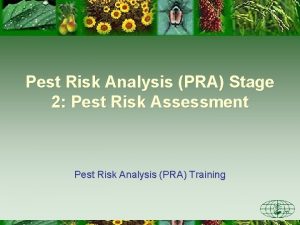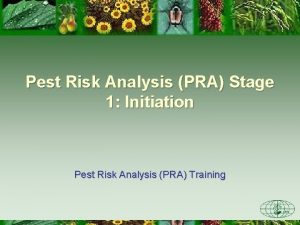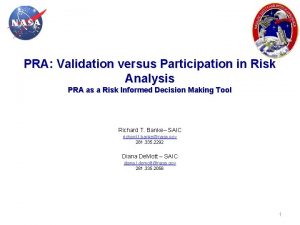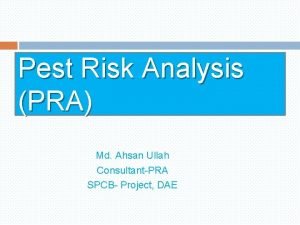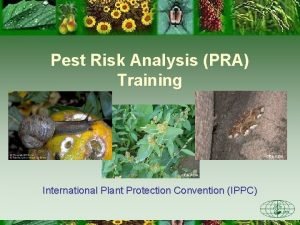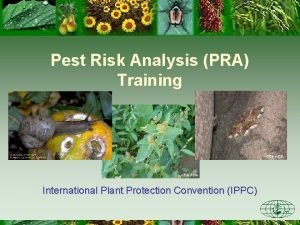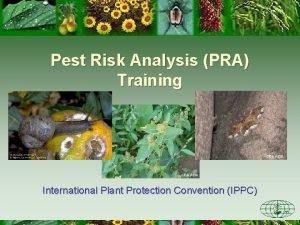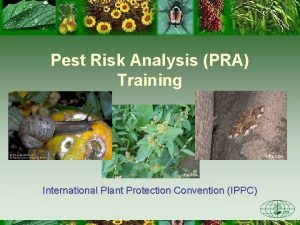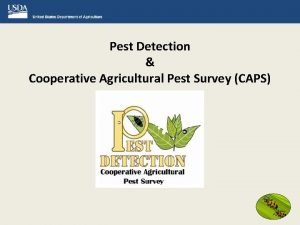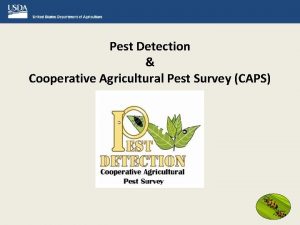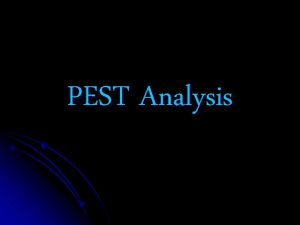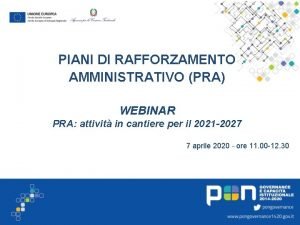Pest Risk Analysis PRA Stage 2 Pest Risk




























- Slides: 28

Pest Risk Analysis (PRA) Stage 2: Pest Risk Assessment

Overall Assessment of Risk

Outline • • • Part of the pest risk assessment process Qualitative descriptions - free text Qualitative descriptions – word scales Group discussion Summarising aspects of risk assessment Combining likelihood and impact – Summarising the summary!

Stages • Stage 1: Initiation • Stage 2: Pest Risk Assessment – Step 1: Pest Categorization – Step 2: Assessment of the Probability of Introduction and Spread – Step 3: Impacts – Step 4: Overall Assessment of Risk – Step 5: Uncertainty • Stage 3: Pest Risk Management

Overall assessment of risk • Combines the likelihood of pest introduction with the consequences of that introduction • “Without any mitigation measures, the pest is likely to be present on (host) from (origin) and to be able to survive transport and reach suitable hosts such as …. which are widely distributed in the PRA area”

Overall assessment of risk • Combines the likelihood of pest introduction with the consequences of that introduction • “Without any mitigation measures, the pest is likely to be present on (host) from (origin) and to be able to survive transport and reach suitable hosts such as …. which are widely distributed in the PRA area and could cause yield losses of up to 15% during a severe outbreak”

Overall assessment of risk • “Although the pest can spread (be introduced – enter and establish) from neighbouring country …. . impacts are likely to be very low” • Improvement

Overall assessment of risk • “Although the pest can spread (be introduced – enter and establish) from neighbouring country …. . impacts are likely to be very low” • Improvement • “Although the pest is very likely to spread (be introduced – enter and establish) from neighbouring country …. . impacts are likely be very low”

Overall assessment of risk • Summarise using words – Advantages – Disadvantages • Alternative approach?

Summarising aspects of PRA • Word scale • Likelihood – Very unlikely – Unlikely – Likely – Very likely

Summarising aspects of PRA • Word scale • Impact – Negligible – Low – Medium – High

Guidelines for rating establishment • Negligible • The pest has no potential to survive and become established in the PRA area. – Stewart’s wilt of corn (Erwinia stewartii (Smith) Dye) distribution is limited by the overwintering capabilities of its insect vector, the corn flea beetle (Chaetocnema pulicaria Melsheimer). In most years, winter temperatures throughout Canada’s corn-growing regions are too low to allow survival of the insect-vector, in which the bacterium could overwinter.

Guidelines for rating establishment • Low • The pest has potential to survive and become established in approximately one third or less of the range of the host(s) in the PRA area. – Oriental fruit moth (Grapholita molesta (Busck)) distribution in Ontario is primary limited to the south, whereas its hosts are widely distributed in the province.

Guidelines for rating establishment • Medium • The pest has potential to survive and become established in approximately one third to two thirds of the range of the host(s) in the PRA area. – Example: Blueberry Maggot (Rhageletis mendax Curran) distribution is limited by low winter temperatures to the more southerly portions of the range of Vaccinium species in Canada. It will not survive throughout the entire range of blueberry.

Guidelines for rating establishment • High • The pest has the potential to survive and become established throughout most or all of the range of hosts in PRA area. – Example: Current Old World distribution of Cherry Ermine Moth (Yponomeuta padellus (L. )) suggests that the pest could become established in North America wherever its hosts are found.

Summary for rating establishment • • Negligible = no potential Low = 1/3 or less of host range Medium = 1/3 to 2/3 of host range High = most or all of host range

Guidelines for rating introduction • Negligible • The likelihood of introduction is extremely low given the combination of factors including the distribution of the pest at source, management practices applied, low commodity volume, low probability of pest survival in transit, low probability of contact with susceptible hosts in the PRA area given the intended use, or unsuitable climate.

Guidelines for rating introduction • Low • The likelihood of introduction is low but clearly possible given the expected combination of factors necessary for introduction described before

Guidelines for rating introduction • Medium • Pest introduction is likely given the combination of factors necessary for introduction described before

Guidelines for rating introduction • High • Pest introduction is very likely or certain given the combination of factors necessary for introduction described before

Guidelines for rating introduction • • Negligible = extremely low Low = low Medium = likely High = very likely or certain

Guidelines for rating impact • Negligible • There is no impact on yield, host longevity, production costs or storage. – Example: Septoria leaf spot (Septoria ampelina Berk. and Curtis) infection results in leaf drop in grape that is premature by a few days only, with no treatment necessary and no economic losses.

Guidelines for rating impact • Low • The pest has a minor impact on the standing crop and little effect on the stored products. – Example 1: Apple Rough Skin agent is responsible for loss of marketability of fresh fruit and is most significant on the apple varieties Golden Delicious, Belle de Boskoop, Schonen van Boskoop and Glorie van Holland.

Guidelines for rating impact • Medium • The pest has a moderate impact on the standing crop but host mortality is rare; losses in storage may occur. – Example: Apple maggot (Rhagoletis pomonella (Walsh)) is a fruit borer. Losses may be up to 75% of fruit if left untreated.

Guidelines for rating impact • High • The pest has a severe impact on the standing crop with significant host mortality; losses in storage may be total. – Example: All species of oak are susceptible to Oak wilt (Ceratocystis fagacearum (Bretz) Hunt), although less severe symptoms are demonstrated by those in the white oak group. Red oaks are usually killed within a few weeks to one year of initial infection.

Risk matrix High Medium Impact Low Negligible Low Medium High Likelihood of introduction

Risk matrix High Medium Impact Low Negligible Low Medium High Likelihood of introduction

Summary • • • Part of the pest risk assessment process Qualitative descriptions - free text Qualitative descriptions – word scales Summarising aspects of risk assessment Combining likelihood and impact – Summarising the summary!
 Market risk assessment
Market risk assessment Pestle analysis of tesco
Pestle analysis of tesco Aquaculture pest analysis
Aquaculture pest analysis Pest analysis template
Pest analysis template C-pest analysis for an event
C-pest analysis for an event 1st stage denial
1st stage denial It is the position of the acting area about the audience
It is the position of the acting area about the audience Stage right and left
Stage right and left Single stage procurement
Single stage procurement The word drama comes from
The word drama comes from Stage right stage left
Stage right stage left Pra penelitian kualitatif
Pra penelitian kualitatif Minit mesyuarat disediakan oleh
Minit mesyuarat disediakan oleh Contoh ronde keperawatan hipertensi
Contoh ronde keperawatan hipertensi What is pra
What is pra Pra covek
Pra covek What is pra
What is pra Tahap-tahap penulisan karya ilmiah
Tahap-tahap penulisan karya ilmiah Tamhidi meaning
Tamhidi meaning Langkah langkah bimbingan klasikal
Langkah langkah bimbingan klasikal Contoh rra dan pra dalam penyuluhan pertanian
Contoh rra dan pra dalam penyuluhan pertanian Participatory rural appraisal
Participatory rural appraisal Reprodução celular
Reprodução celular Apa itu biaya pra investasi
Apa itu biaya pra investasi Pra que saber meu nome saber do meu passado gian e giovani
Pra que saber meu nome saber do meu passado gian e giovani Pra efa exemplos
Pra efa exemplos Arsitektur pra modern
Arsitektur pra modern Acorda pra vida tem um dia lá fora
Acorda pra vida tem um dia lá fora Diagram venn pra
Diagram venn pra

